Below, we look at eight patterns of play you can use in the 4-4-2 system, four are for central penetration while the other four are for wide penetration.
If you are coaching the 4-4-2 system or you are participating in any high-level coaching courses such as the UEFA A or B licence where patterns of play are a requirement you may find the below valuable.
First, we look at the patterns, but more importantly, we show you how you can get success on the training ground through the use of field mapping and the players’ discovery of ‘what if’s’.
Below we will look at:
- Why train patterns of play
- Central patterns
- Wide patterns
- The training ground
- Getting success
Why train patterns of play
Bottom line, we train patterns of play to help players identify and execute pre-determined passing and moving combinations to beat the opponent’s defence.
Sometimes that may mean penetration to score a goal, other times it may also mean playing through the opponents forwards or midfield to get through their defensive block or pressure.
Executing patterns do not always deliver the desired results; however, depending on the targeted outcome, secondary success can be achieved.
Consider that creating a goal-scoring opportunity was the aim, having been stopped short in the execution of the pattern of play your team could have won a corner, penalty or free-kick in a dangerous area.
Nevertheless, even retaining possession through good passing and movement can serve to disorganise the opponent’s defence, whereby your team can redistribute possession to another area of the field to have a better chance to penetrate.
If you are a coach, also consider individual and team confidence.
When the attacking team is only playing in reaction to one another, this means they are trying to discover moments and gaps out of pure randomness to get success.
At the same time, the opponent can anticipate and defend.
The likely outcome is a lot of technical and tactical errors that subsequently result in higher turnovers, which weighs a players confidence.
On the other hand, when you have a team that knows the system and they can execute plays on minimal touches, and at such a high speed the opponent cannot always react to this, which in turn, offers a higher chance of success.
Below we have an example as to how a pre-determined pattern of play used by Juventus to play through and penetrate the Inter Milan defence in their most recent Serie A meeting.
Notice that Inter Milan have man-marked all of the Juventus players in their half.
The passing and moving combination used here by Juventus is represented as ‘Pattern: Wide C’ below.
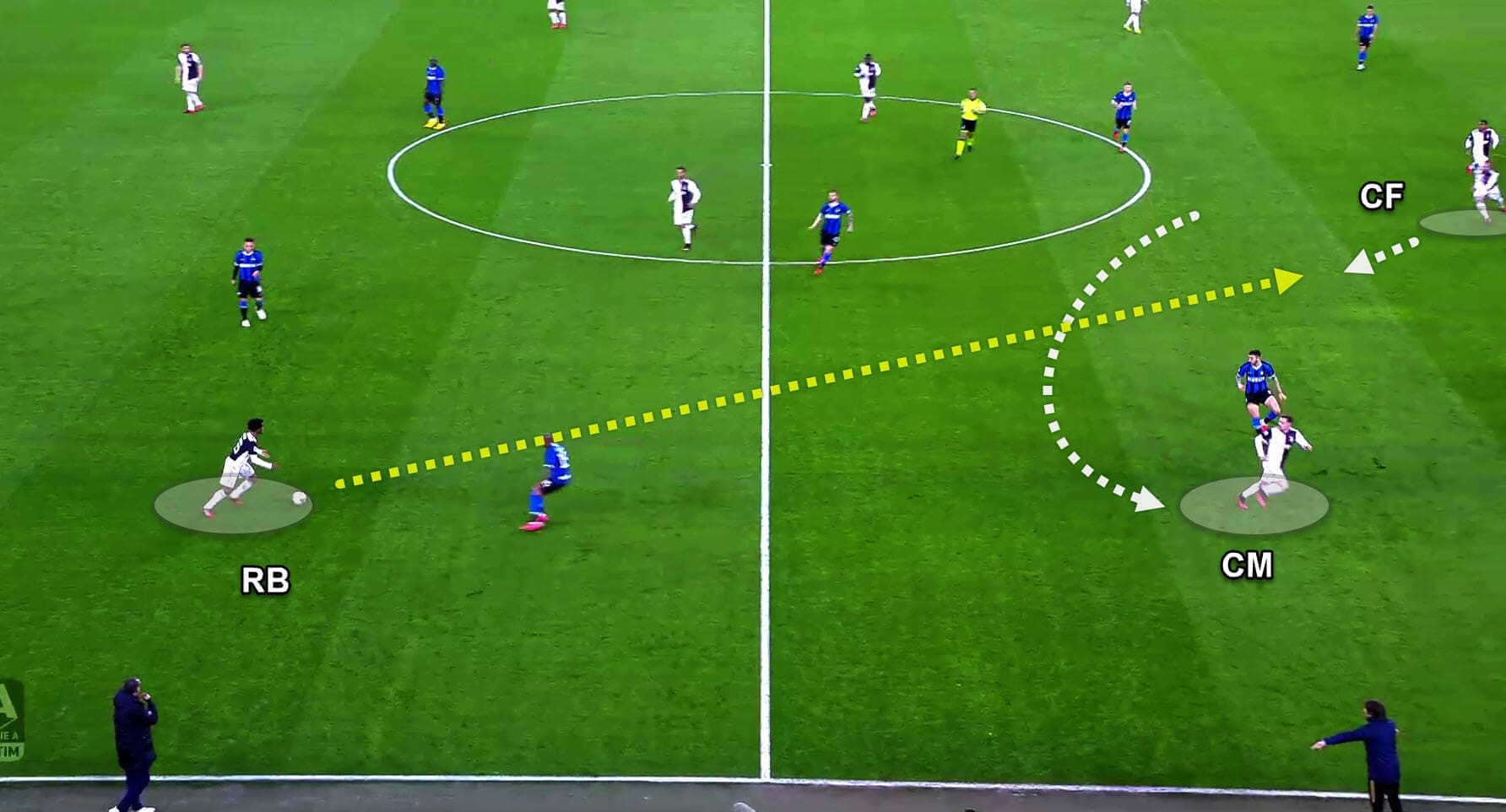
Above we see the Juventus ‘RB’ is looking to play a forward pass to progress the attack.
Moments before the ‘RB’ plays the pass the ‘CM’ Aaron Ramsey makes an angled run from the centre to the right side of the field.
As the ‘CM’ vacates the space, the ‘CF’ Gonzalo Higuaín drops in to receive the pass from the ‘RB’.
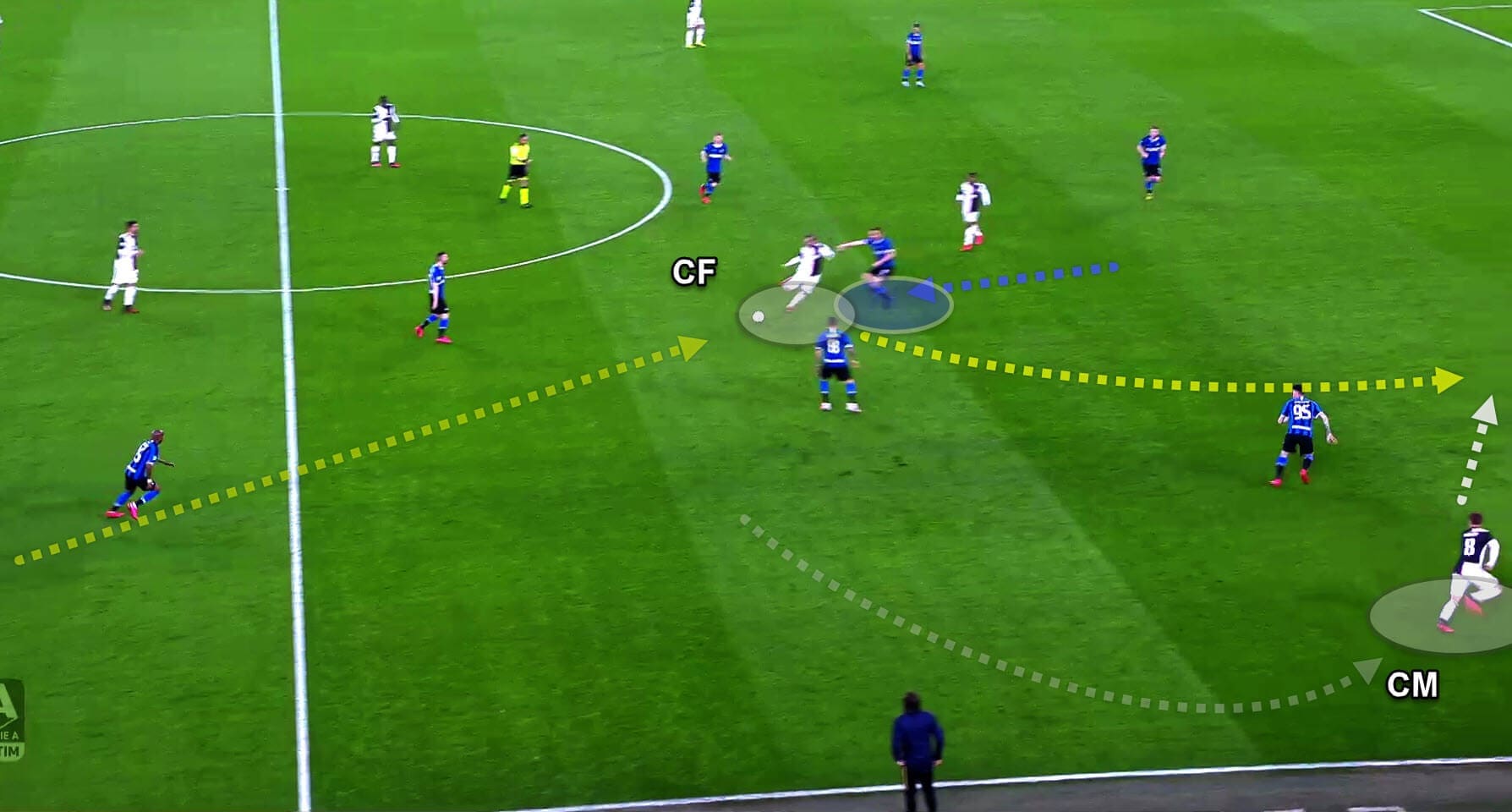
On his first touch, the ‘CF’ plays a penetrating pass into the space for the ‘CM’ to meet on his run into the box.
Two elements are crucial for this pattern to work; passing quality and movement.
If the first pass from the ‘RB’ is poor, then the ‘CF’ can not play a first-time pass to beat the defence.
Similarly, If the ‘CM’ is late making his run, he does not get to the ball ahead of the defender; also if he is too early making his run, he’s caught offside.
Central Patterns in 4-4-2
The primary difference between central and wide penetration is that central patterns in the opponents half generally result in players arriving in good goal-scoring positions.
As for wide patterns that come to fruition, they typically result in wide crossing positions or dribbling opportunities into the box from a wide position.
That is unless the pattern includes the final ball into the box.
Note, all patterns of play can be mirrored to both sides of the field.
Central A
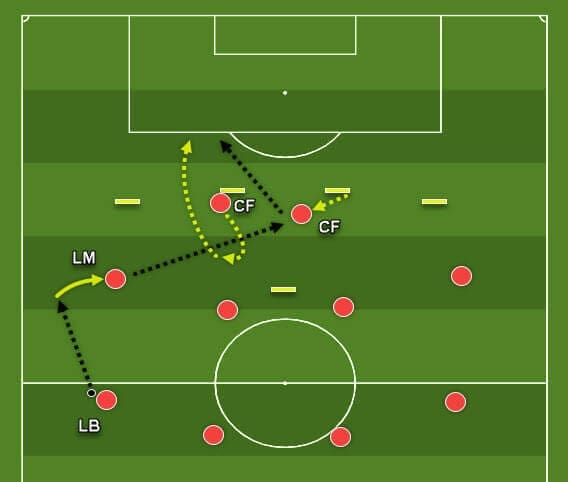
- The LB plays a pass to the LM, who then, in turn, takes a touch inside before passing
- The LM’s first touch is the trigger for the CF (left) to make his short-run deep
- The LM’s ground pass should be intended to connect with the CF (right)
- The CF (left) offers a disguise by appearing to receive the pass only to dummy and leave it for the CF (right)
- Immediately after the dummy, the CF (left) sprints into the space created by pulling the defender away on his dummy run
- The CF (right) looks to play a one-touch pass forward into the run of the CF (left) to get success: all three passes should be firm ground passes, the CF (right) needs to play the third pass with one touch to beat the offside and avoid being defended
Central B
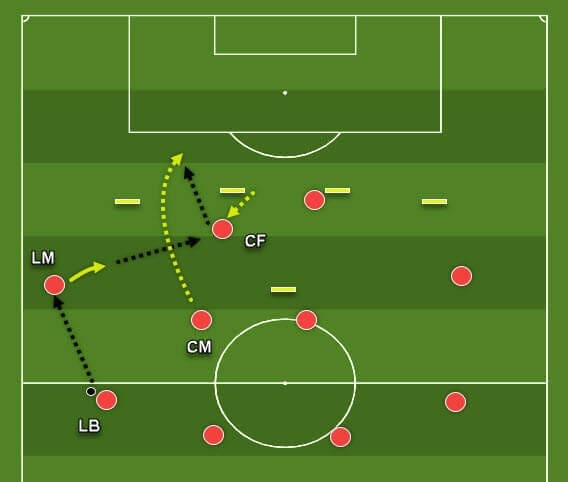
- The LB plays a firm pass to the LM; the LM takes a touch inside before passing to the CF
- When the LM takes a touch inside that is the trigger for the CF do drop into space
- As the LM is about to play the pass, the CM sprints into the space between the opposition CB & FB
- As the CF receives a pass from the LM he should then offer a one-touch flick or pass into the run of the CM
- This combination works well on shorter distances although the CM must be at an angle to the CF so to be at a comfortable distance to receive a pass entering the box.
- The one-touch pass from the CF and the speed of the CM’s run is crucial to get success.
Central C
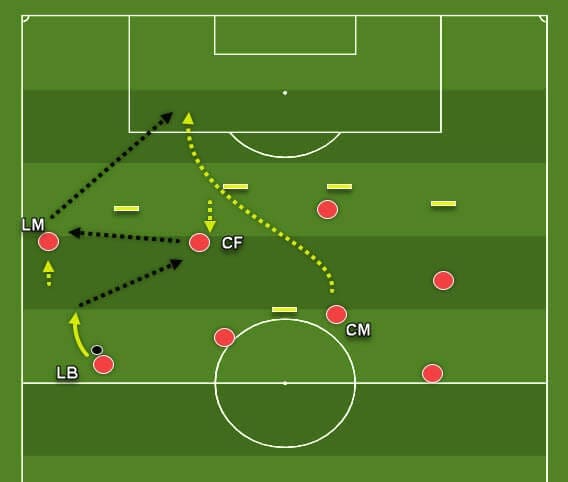
- The LB take a touch forward, that then is the trigger for both the CF and the CM to make their run
- The LM should hold the width here as the wide-angle for the final pass is key to getting success
- The LB plays a firm pass to meet the run of the CF
- The CF lays off a slightly forward ground pass to the LM, at this stage, the CM must be at full sprint.
- The timing of the run from the CM is critical to determine whether the LM has to play a one-touch pass or delay.
- In order to beat the offside line as well as not allowing the opposition time to re-organise the LM should ideally play a one-touch pass into the run of the CM.
- The CM can give himself and his team a better chance by angling his run before a sharp change of direction on his sprint to beat the offside line if he is a little early on his run.
Central D
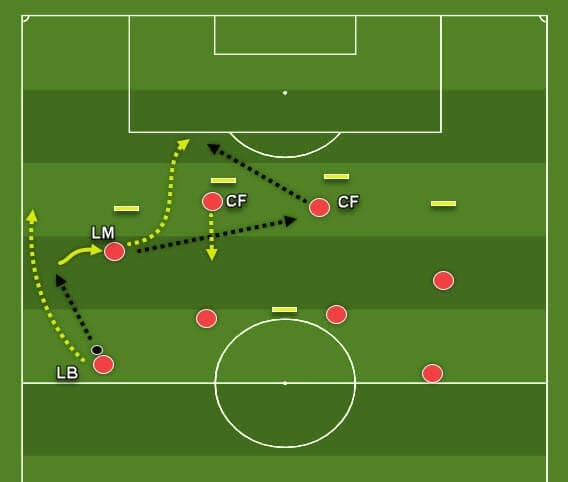
- As the LB plays a pass to the LM he immediately starts his run to overlap the LM
- The LB’s overlapping run is key to creating width in the opposition defence by engaging the opposition full-back.
- The LM takes a touch inside, that is the trigger then for the CF (left) to drop into the space.
- The LM plays a straight pass intended to meet the feet of the CF (right)
- The CF (left) should look to offer a dummy or disguise control on the second pass
- After playing the second pass the LM sprints and angles his run between the space between the stretched full-back and the centre-back who should be engaging the CF (left)
- The LM must offer the CF (right) a good ground pass so he can play a reverse pass forward with one-touch
- Allowing the final pass to be a one-touch pass and the timing of the run from the LM is crucial to get success.
Wide patterns in 4-4-2
Again all patterns can be mirrored on both sides of the field.
The ‘yellow’ icons on the field represent mannequins, work at your own pace as you may want to gradually introduce one, two or three defenders along with the mannequins over time.
Wide A
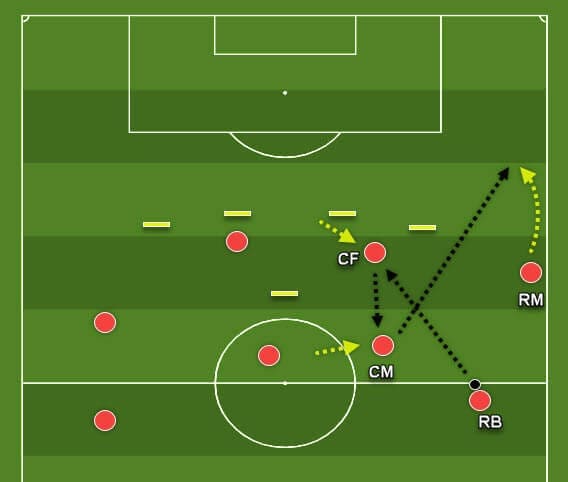
- The RB takes a touch forward before passing; this is the trigger for the CF to drop to receive a pass
- The RB plays a long firm ground pass to the CF, with no more than two-touches the CF lays off a pass to the CM
- The CF’s first touch is the trigger for the RM to start his run, the wider the RM is before starting his run, the better, as this position would serve to allow him an angle to arc his run, as well as to stretch the opposition full-back to create a gap for the CM’s pass
- The CM should look to play a one-touch pass into the channel to meet the forward run of the RM. So the passing qualities remain crucial from the beginning.
Wide B
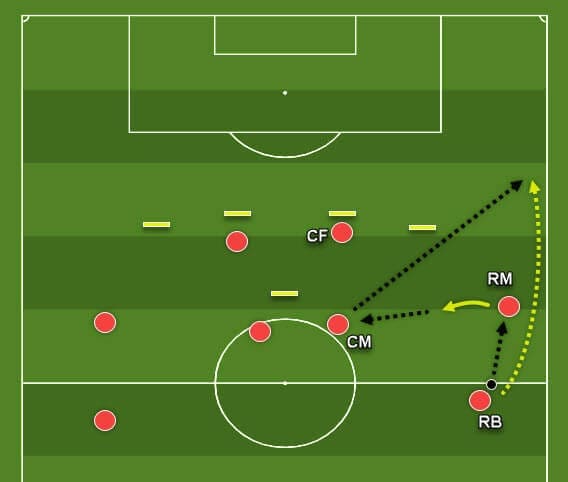
- The RB plays a forward pass to the RM; the RM takes a touch inside to create space for the RB who makes an overlapping run at pace
- The RM plays a firm ground pass that the CM can play a one-touch pass with
- Before receiving the CM may have to move away from the play to create space then move back to receive a pass unmarked
- The CM should look to play a perfectly weighted through ball into the channel to meet the run of the RB.
Wide C
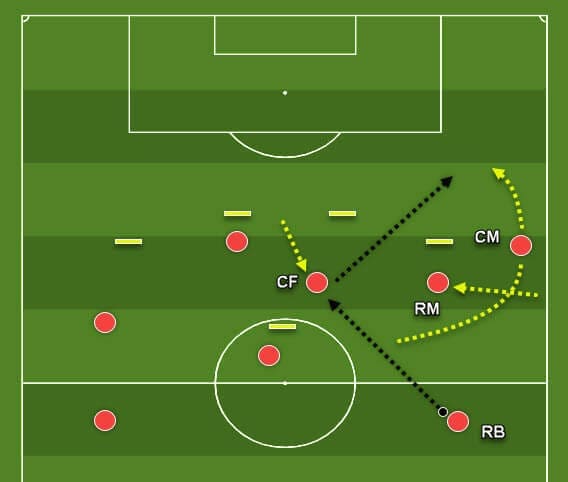
- The RB takes a touch forward; this is the trigger for the CF to drop into space
- Simultaneously the CM makes an angled run from midfield around by the channel and forward
- The RB should play a long but accurate ground pass that the CF can play forward with one-touch
- As the ball is travelling to the CF, the RM should move inside to offer an inside option unmarked
- The CF must adjust his body well to play a long reverse pass forward into the channel ahead of the run of the CM
- The more angled the CM’s run is, the better it is to time beating the offside line to meet the final pass
- Passing qualities as well as the CM’s run to beat the offside is crucial
Wide D
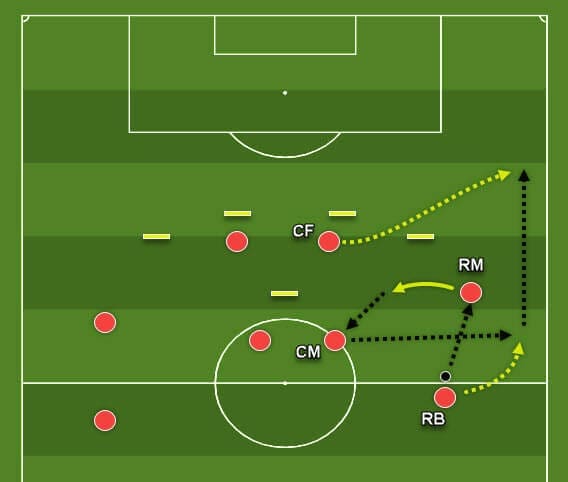
- A four-pass move involving four players, passing qualities as well as timed runs will be crucial
- The RB plays a forward pass to the RM who takes a touch inside to create space in the channel
- The CM make s a short run to receive a pass unmarked, from there the CM plays a pass out wide to meet the short forward run of the RB
- The CM’s pass is important, such that he needs to give the RB a perfectly weighted pass that he can subsequently play forward with one-touch
- As the CM plays a pass out wide to the RB, then the CF needs to make an angled sprint into the channel to meet the first-touch pass from the RB.
- The CF should not run early as he will be marked and the angle for the pass will be read and blocked by the opposition full-back. The CF must start his run as late as possible and make an angled sprint into the channel.
- If the CF is followed by the opposition centre-back into the channel, then the RM and the second CF must identify and exploit the gaps in the defence with fast forward runs.
- From the fourth pass, the CF should adjust his body to face the box as early as possible to identify the options/gaps.
The training ground
Here we look at the implementation for effective learning.
For the format of these types of sessions, I would promote training the patterns unopposed in the beginning and gradually introduce defenders. As the patterns can be mirrored on both sides of the field, I would encourage setting up your preferred pattern on both sides of the field and have them working in alternation to one another.
After working on perhaps no more than two per session, we then go into a conditioned game outlined below, which is designed for players to become tactically aware in the 4-4-2 formation of their options and to help the players identify opportunities to execute those trained options.
Mapping the field
Mapping the field is not a new concept; however, it is becoming more commonplace and referenced by tactical analysts and writers in annotations.
The advantage of mapping the field is that it supports the coach in his or her aims to tactically educate the players.
As well it also creates habits in players by training in condition to the designated channels and zones.
There are many ways to map a field; some choose vertically, some choose horizontally while some honour a hybrid of both.
None of which are the authority, mapping has always been a subjective and personal preference to coaches and teams.
Through the use of mapping, terms like, ‘half-space’ and ‘Zone 14’ were born.
If this is alien to you, do not worry, that does not concern us or hold any value here.
Instead, how we map the field for training patterns is both simple and effective for player and team development.
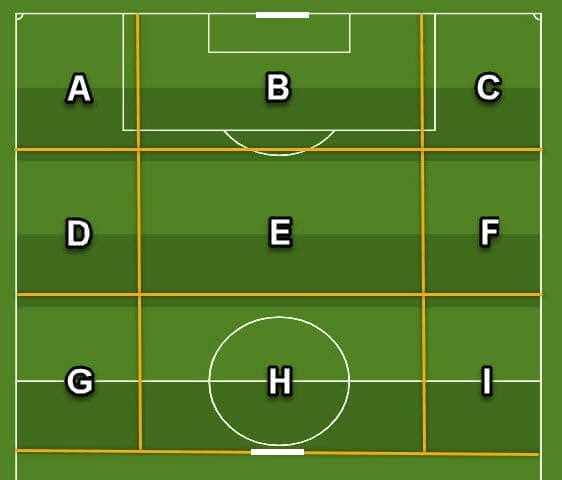
We are going to create nine zones inside one half of the field; however, going a little bigger or smaller is completely fine.
The two vertical lines can be made by coming in approximately two-to-five yards inside the box and making a channel with cones reasonably spaced.
Secondly, the two horizontal coned lines should reflect three evenly spaced thirds of the half.
To help with player buy-in as well as understanding, why not ask the players to line the field for you by showing them the image.
As for the naming of each zone ‘A-B-C’, this is simply for referencing to support the coaches understanding.
For the players own tactical learning, you can use the same letter reference system, numbers or even designate colours to the area based on the colour of the cones you have laid down in those specific zones.
Once the field has been set up, then we look at creating a conditioned game that honours the 4-4-2 shape.
Conditioned Game
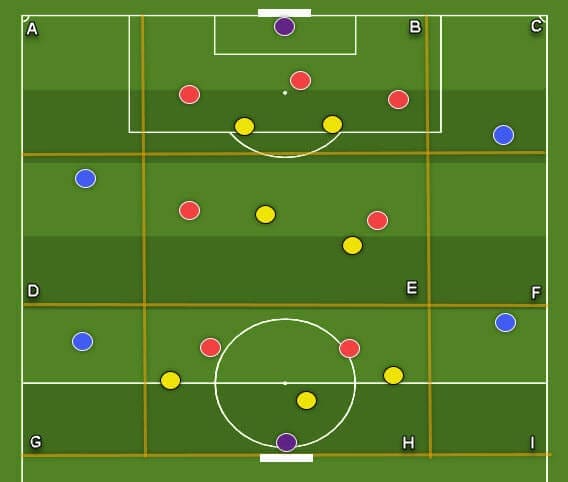
- After setting up the field, arrange three teams out of blue, yellow and red.
- Yellows play against reds in set up as GK+3-2-2 formation
- The blues remain as neutrals in the channels, and they are with the team in possession.
- Such that when the yellow team are attacking the two highest blues in zones’ D’ and ‘C’ act as left and right-wingers respectively. Similarly, the blues in zones’ G’ and ‘I’ are acting fullbacks.
- Have players honour their primary and secondary positions in this conditioned game.
- Conditions for movement: You can start with certain restrictions and change as you progress to help facilitate different outcomes. Such as the blues can go between all zones; however, for the game will naturally require them to hold wider positions unless a winger (blue) is meeting a cross at the back post for example.
- Allow the defending team to send one player out to the channels to defend against the blues. This will help players identify and utilise central overloads.
- To incentivise getting success, offer the attacking team a goal each time they execute a pre-determined pattern of play successfully, and three goals if they score from that same play.
- The value of this conditioned game is not only helping players identify overloads and free players but to also coach players on ‘what-ifs.’
- A what-if is when a pattern of play cannot be completed as planned then the player being denied the opportunity to complete his pass has to find his remaining options, this we refer to as a ‘what-if’.
- In Lehmann’s terms a ‘what if’ can be understood as when a planned passing sequence may be a pass from A to B to C. However, If ‘C’ is blocked then ‘B’ may pass back to ‘A’ or forward again to ‘D’.
Options & what-ifs
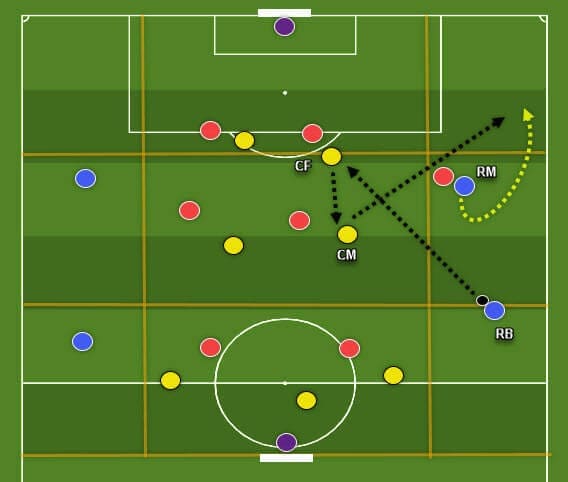
Above we see an illustration of the yellow team combining with the blue team to play pattern ‘Wide A’.
As annotated above the blue players are acting winger and full-back.
These conditioned games offer the opportunity to identify the option in a controlled space while still having the realism of reactive defenders out to disrupt the passing sequence.
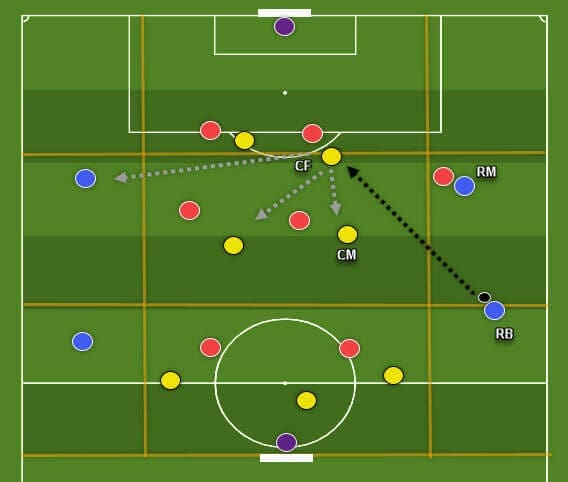
In the illustration above, we see how a player might categorise and identify his ‘what-if’ options if the pattern cannot be completed as planned.
The black line represents the first pass to the striker while the broken grey lines represent the strikers’ options when in possession.
Assessing all options from left to right, the first option is an attacking pass to the opponent’s weak side on the left.
Should the CF have the ability and opportunity he can play to the LM (blue) in zone’ D’.
The two next options would be either CM who are supporting from behind.
By mapping, the field players are better able to assess their options in a game situation to pick the best option if the penetrating pass is denied to them.
Getting success
The biggest challenge is getting players to identify all at once the trained pattern of play at the same time in a 90-minute match.
However, with the right conditions of open play in training, we can develop each players capacity to read the game and identify those moments.
I have found this methodology of field mapping in a conditioned game to be an effective learning method by training the players’ ability to identify moments to use patterns of play in a competitive match.
Options central and wide: We have outlined a total of eight options for a team who plays in the 4-4-2 system to seek out, create and execute.
Passing qualities, as well as the right timing and movement, will always be crucial essentials to get success.
In the beginning, when working with your players, narrow it down to one or max two patterns in a week.
Let them get used to this, learn the pattern well and build confidence.
What-If’s: *This is usually where a coach has to show his value as a mentor, as there will be plenty opportunity for stoppages in the conditioned game, helping the players discover their what-ifs will be crucial for developing a confident possession-based team. Remember it is essential for players to identify not only their patterns of play but also know their what-ifs if the desired outcome cannot be reached.
Mapping the field: Not only for training patterns of play, there will also come secondary success from this methodology of mapping the field.
Players improve their tactical awareness, and by understanding certain positions to certain zones at certain times, it serves to help them in their decision making and subsequently their confidence.
Mindset, repetition and patience: Try not to hurry success too early, the more you handover performance ownership to the player and create the correct mindset within the group the sooner you will see the rewards of this training.
Facilitating a mindset of discovery and problem solving over error avoidance and forcing opportunities will significantly improve the players learning as well to help create the desired outcome.
If you enjoyed and found this article valuable, or you still have some questions or want to discover more, write to me on Twitter @easytactics.
I will follow up with another coaching piece soon on ‘getting success with wingers attacking from opposite flanks’, only here on totalfootballanalysis.com.

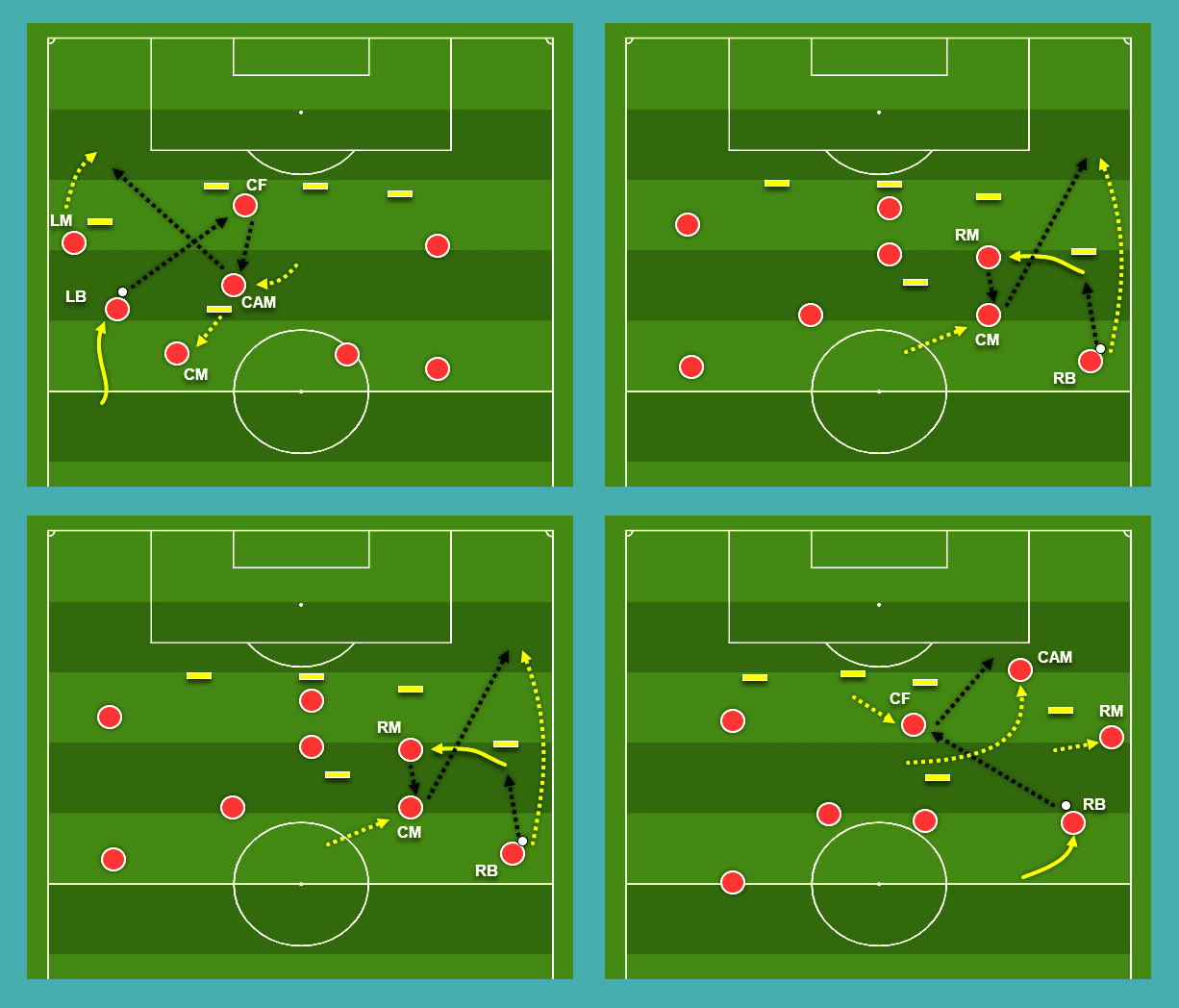


Comments